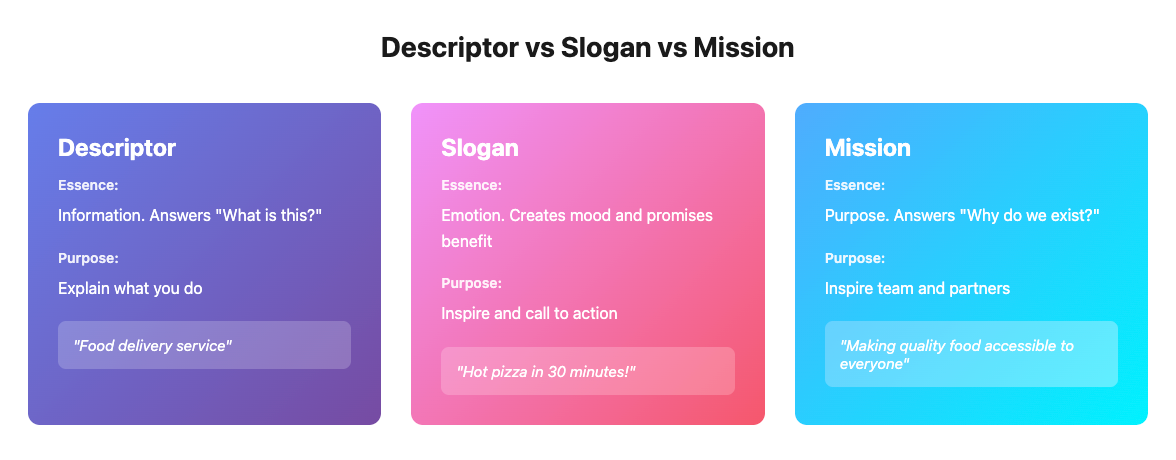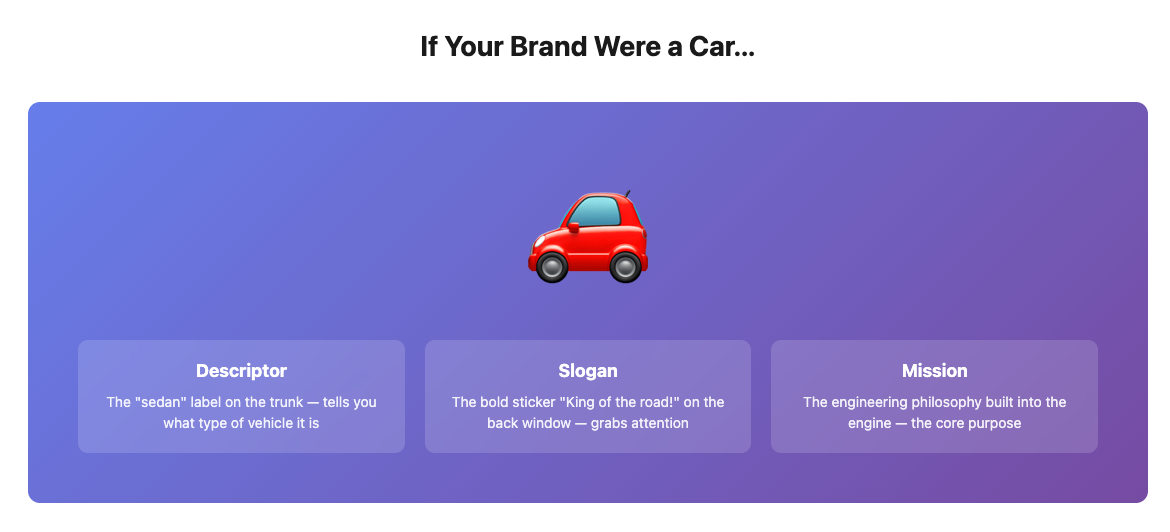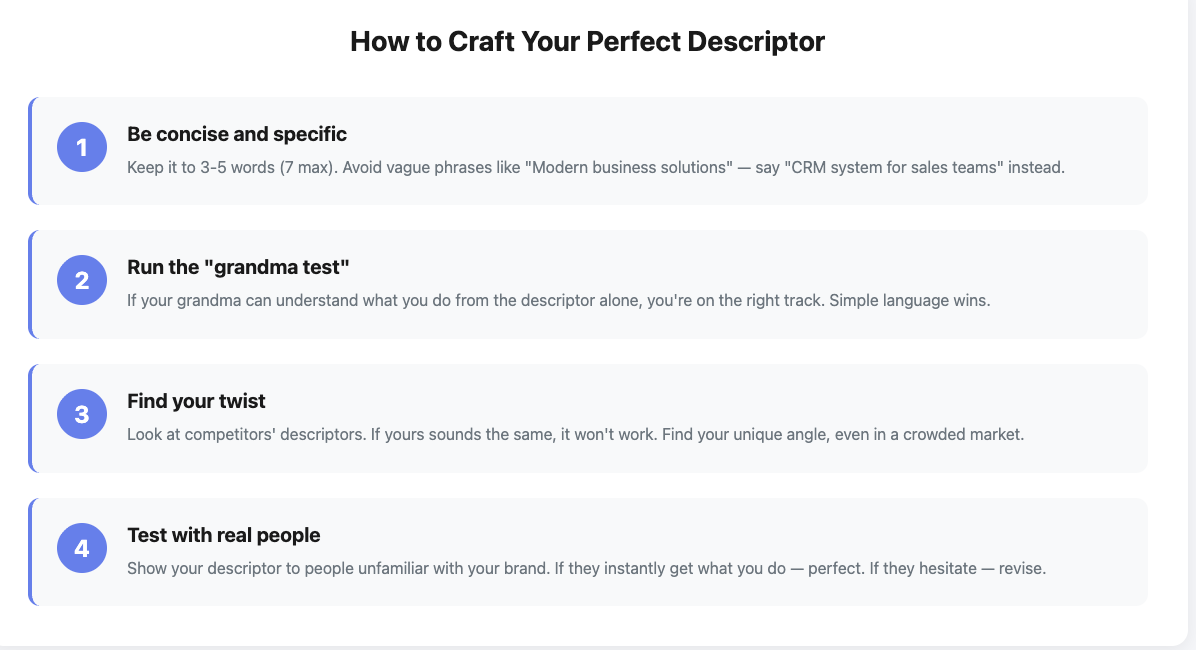Descriptor


Marketer Elena is sitting in a meeting with a new client — the founder of a startup called Lyra.
A beautiful name, it sounds nice, but... what’s behind it? A music school? A jewelry boutique? Maybe a cozy coffee shop?
No one on the team could say for sure what this business was about.
Elena came up with a brilliantly simple solution.
Under the elegant Lyra logo, she added a short line:
“Online platform for musicians.”
Just three words — but they changed everything.
Now, anyone who saw a business card, opened the website, or flipped through a presentation instantly understood what Lyra offered. Questions disappeared, and the website finally began turning curious visitors into real users.
That magic phrase is called a descriptor.
Its job isn’t to impress or inspire — it simply explains who you are and what you do.
And in that simplicity lies its incredible power, especially for young companies whose names haven’t yet made it into the spotlight.
So, what is a descriptor?
Simply put, a descriptor is a short and clear explanation that accompanies your company’s name or logo.
It answers the question: “What do you actually do?”
It’s not an ad slogan or a call to action — it’s a practical clue for those seeing you for the first time.
Imagine you come across a sign with the proud name Aurora.
What could it be? A spaceship? A new kind of apple? A publishing house?
While you’re guessing, your attention is already gone.
Now add a small detail: “Network of dental clinics.”
Mystery solved. The picture comes together.
The descriptor worked like a caption under a photo — turning confusion into clarity.
Descriptor, slogan, mission: what’s the difference?
Many new entrepreneurs confuse these three concepts. Let’s sort them out once and for all.
- Descriptor — states the fact. It defines what you are.
Example: “Food delivery service.”
- Slogan — evokes emotion and benefit. It promises something and sets a mood.
Example: “Hot pizza in 30 minutes or your money back!”
- Mission — expresses purpose and values. It answers “Why do we exist?” and usually lives inside the company, inspiring the team.
Example: “Making quality food accessible to everyone.

Each has its place and purpose.
Types of descriptors
Descriptors, like people, come in different types — depending on what they emphasize.
1. Functional: “What we do”
The most straightforward type.
It directly states your product or service:
“Online clothing store,” “Legal consulting,” “Georgian restaurant.”
No metaphors, just clarity.
Perfect for clear, specific niches.
When someone’s hungry for khinkali, they don’t need poetry — they need a sign that says “Georgian restaurant.”
2. Audience-based: “Who we work for”
This one targets your audience directly:
“Bank for entrepreneurs,” “App for freelancers,” “Store for expectant mothers.”
It instantly builds a connection with the right people.
If your product solves a specific group’s problem — say it openly.
It filters out irrelevant traffic and attracts the people who actually need you.
3. Value-based: “What makes us special”
This is advanced level.
Such descriptors not only name your category but also hint at your unique benefit:
“Fast grocery delivery,” “Reliable logistics,” “Affordable English learning.”
They balance information with a touch of positioning.
Just don’t overdo it.
Words like “best,” “unique,” or “innovative” turn your descriptor into empty noise.
How to craft the perfect descriptor
Creating a good descriptor is an exercise in honesty.
Ask yourself: “What do we really do?”
Forget about being original for a moment — clarity comes first.
Be concise and specific
A perfect descriptor is 3–5 words long (7 max).
Each extra word is friction.
You’ve got only a couple of seconds to make people understand who you are — don’t waste them.
Avoid vagueness like “Modern business solutions.”
Better say “CRM system for sales teams.” — concrete and clear.
Run the “grandma test” — explain your business using only the descriptor.
If your grandma gets it, you’re on the right track.
Find your twist
Hint at what makes you different.
If speed is your thing, let it show.
If you have a niche — name it.
Look at your competitors.
If your descriptor sounds like a weak copy of theirs, it won’t work.
Find your own angle.
Test it on people
Once you’ve got a few options, show them to people unfamiliar with your brand.
Ask: “Can you tell what we do?”
If they get it immediately — bingo!
If they hesitate — back to the drawing board.

Conclusion
Let’s go back to Elena and Lyra.
Those three simple words under the logo became the company’s springboard.
Clients stopped guessing, partners saw potential, and investors saw focus.
Two years later, Lyra is now a well-known platform.
The descriptor is still there, but needed less often — like a grown child keeping parents’ number “just in case.”
A descriptor isn’t a fancy accessory.
It’s your compass in the stormy sea of business.
In a world where new companies appear every second, it helps you stand out and find your audience.
It’s that first handshake that silently says:
“Hi. Here’s who we are. And here’s how we can help you.”
A good descriptor works quietly, without applause.
It simply explains.
And for a successful start, that’s more than enough.


